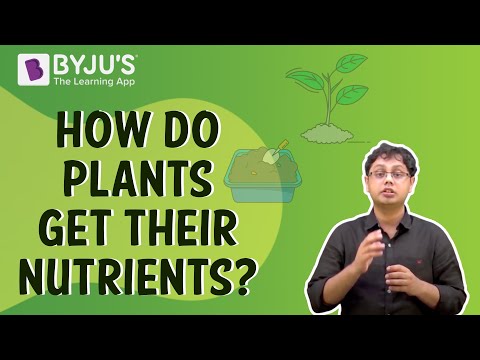Nutrients are the components found in our food such as carbohydrates, vitamins, minerals, fats, etc. These components are necessary for living organisms to survive. Plants produce their own food while animals and human beings do not produce their own food. We indirectly or directly depend on plants and animals for our food needs.
Table of Contents
Modes Of Nutrition
The process of obtaining food and utilizing it to grow, stay healthy and repair any damaged body part is known as nutrition. Plants produce their food by taking raw materials from their surroundings, such as minerals, carbon dioxide, water and sunlight. There are two modes of nutrition:
- Autotrophic – Plants exhibit autotrophic nutrition and are called primary producers. Plants synthesis their food by using light, carbon dioxide and water.
- Heterotrophic – Both animals and human beings are called heterotrophs, as they depend on plants for their food.
Also Refer: Different Modes Of Nutrition in Living Organisms
Recommended Video:

Autotrophic Nutrition in Plants
Photosynthesis
-
Plants are able to produce their own food through a process called photosynthesis.
-
The chloroplast is the site of photosynthesis.
-
Food production primarily is carried out in leaves. Water and minerals from the soil are absorbed by the root and transported to the leaves through vessels. Carbon dioxide reaches leaves through stomata – which are small pores on leaves surrounded by guard cells.
-
Chlorophyll is a green pigment present in leaves which helps the leaves capture energy from sunlight to prepare their food. This production of food which takes place in the presence of sunlight is known as photosynthesis. Hence, the sun serves as the primary source for all living organisms
-
During photosynthesis, water and carbon dioxide are used in the presence of sunlight to produce carbohydrates and oxygen.
-
Photosynthesis provides food to all living beings.
-
Oxygen, one of the main components of life on earth is released by plants during photosynthesis.
Also Refer: Photosynthesis
Conditions necessary for Photosynthesis
-
Sunlight
-
Water
-
Carbon dioxide
-
Chlorophyll
Steps in Photosynthesis
-
Absorption of energy from sunlight
-
Conversion of light energy into chemical energy
-
Hydrolysis of water into oxygen and hydrogen
-
Carbon dioxide is reduced to form glucose by utilizing chemical energy
Also Read: Nutrition in Animals
Heterotrophic Nutrition in Plants
Some plants do not contain chlorophyll and depend on other plants for their food through the heterotrophic mode of nutrition. These type of nutrition in plants are referred to as Heterotrophic nutrition in plants, hence are called parasites.
Heterotrophic Plants
Listed below are different types of heterotrophic plants that are mainly classified based on their mode of nutrition:
-
Parasitic
-
Insectivorous
-
Saprophytic
-
Symbiotic
Parasitic Nutrition
Some heterotrophic plants depend on other plants and animals for nutrition. Such plants are known as parasitic plants. However, the host is not benefitted from the parasite.
For eg., Cuscuta, Cassytha
Also Read: Parasitism
Insectivorous Nutrition
Some plants have special structural features that help them to trap insects and are commonly known as carnivorous or heterotrophic plants. These plants digest the insects by secreting digestive juices and absorb the nutrients from them. These plants grow on the soil that lacks minerals.
For eg., Pitcher plant, Venus flytrap
Also Read: Insectivorous Plants
Saprophytic Nutrition
The saprophytic plants derive nutrition from dead and decaying plants and animals. They dissolve the dead and decaying matter by secreting digestive juices and absorb the nutrients.
For eg., mushrooms, moulds.
Also Read: Saprophytes
Symbiotic Nutrition
When two different plants belonging to two different categories show a close association, they are termed as symbiotic. In this, both the plants are benefitted from each other.
For eg., the association of fungi and trees.
Also Read: Mutualism
Learn more in detail about Nutrition in Plants, Heterotrophic Plants or any other related topics at BYJU’S Biology
Frequently Asked Questions
What is plant nutrition?
Plant nutrition is the study of elements and compounds necessary for plant growth, metabolism and external supply. A plant cannot complete its life cycle in its absence.
What is the main mode of nutrition in plants?
The main mode of nutrition in plants is the autotrophic mode of nutrition. Plants have chlorophyll in their leaves which helps them to produce their own food.
What are the different types of heterotrophic nutrition in plants?
Some plants do not have chlorophyll and depend upon other plants for their food. Such plants exhibit a heterotrophic mode of nutrition and are known as heterotrophic plants. For eg., parasitic plants, insectivorous plants, symbiotic plants and saprophytic plants.
What are insectivorous plants?
Insectivorous plants are the plants that trap insects. Their leaves are modified into special structures which traps the insects and digest it with the help of digestive enzymes to derive nutrition from them.
What are the important nutrients required by the plants?
Plants require two types of nutrients- macronutrients and micronutrients. Macronutrients include nitrogen, phosphorus, potassium, calcium, magnesium and sulphur. The micronutrients include boron, chlorine, copper, iron, manganese, molybdenum, and zinc.
How are the nutrients absorbed by the plants?
Plants absorb nutrients through their roots. They transport nutrients and water up through the stem to the parts that are above ground level.

thanks for learning
So helpful. Thank you
So easy to learn
so helpful and thanks
SO HELPFUL FOR US thank you so much
So helpful thank u so much
So helpful
Very helpful thank you byjus
It is so helpful
Thank you very much today is my seminar this is very easy to learn once again thank you soo much
Wow thanks a lot this will really help with my presentation.
Vvery nice